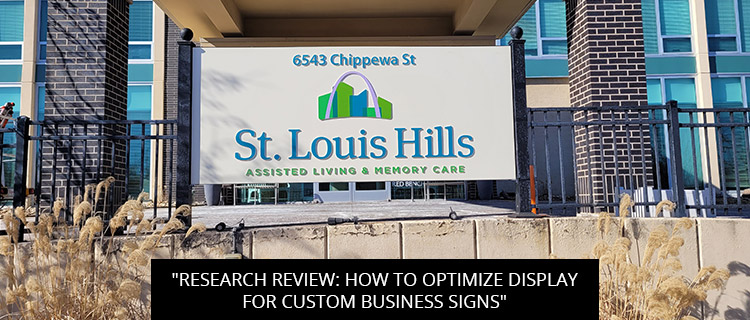Research Review: How To Optimize Display For Custom Business Signs

Today’s post reviews new research from the Interdisciplinary Journal of Signage and Wayfinding that explains how to get more eyes on your custom business signs, without blowing the budget on billboards or other high-traffic display sites.
Read on to learn some budget-friendly best practices for custom business sign display, or call (314) 726-5500 to speak directly with a member of our team in St. Louis, MO.
Declutter Your Display: How To Optimize Display For Custom Business Signs In St. Louis, MO
Location, location, location! We have all heard this old advertising adage extolling the virtues of proper site selection, but what makes a “good” location? To most readers, a “good location” is one that receives plenty of traffic, but is traffic all that counts for effective sign displays?
In a new research report, titled Location, Location, Location: The Effect of Clutter on the Evaluation and Aesthetic Judgment of Off-Premise Signage, authors Jennifer Hong & Mathew Isaac (2020) sought to find out, and the results of their studies might surprise you.
Unsurprisingly, during their preliminary review of literature, Hong & Isaac (2020) encountered plenty of advertising research recommending that custom business signs be “installed and displayed in high-traffic areas, such as along highways and in metropolitan areas, so they can be seen by the highest number of consumers” (Hong & Isaac, 2020, p. 26). The rationale is quite intuitive: the more people who are exposed to your custom business signs, the more who will see your message and take action.
Historically, the main downside to advertising in high-traffic areas with off-premise custom business signs has been the price. Billboards in busy areas often come with a hefty price tag, which can be prohibitive for small businesses.
However, two new studies by Hong & Isaac (2020) suggest that high-traffic areas are not always all they are cracked up to be due to their higher amounts of visual clutter. After all, highly trafficked areas are typically highly competitive, with numerous businesses paying premiums to place signage there.
So What Kind Of Locations Are Best For Custom Business Signs?
Converging evidence across two studies suggests that consumers evaluate custom business signs more favorably when they are displayed by themselves, in low-clutter locations. While the overall number of impressions may be lower than we see in high-traffic locations, low-traffic, low-clutter locations foster more meaningful impressions. This allows your signs to engage viewers on a much deeper level, and ultimately makes your message more memorable and effective.
Thus, if you are looking to display custom business signs off-premise, it may be better to emphasize low-clutter locations, especially as a small business. Multiple studies suggest your signs will perform better in these environments, and you will save plenty of money that would otherwise be spent renting out competitive spots.
These findings have important implications for those who intend to display custom business signs on-premise, too. Specifically, the results of these studies suggest that you should design your sign system in a way that minimizes visual clutter. Thus, you should try to avoid clustering multiple signs together, as this increases the cognitive load on readers, many of whom may choose to ignore your message altogether when presented with a wall of information.
Instead, look to create low-clutter displays that promise quick-and-easy reads, and direct the eye to the most important sign message.
Consult With Custom Business Sign Experts In St. Louis, MO
To learn more about how we can help you optimize your display, and to get a free quote on any custom business sign order, you can:
- Call (314) 726-5500
- Fill out the online contact form on our website to request a callback
- Email contact@horizonsignco.com
- Drop by our location at 748 Hanley Industrial Court in Brentwood
References
Hong, J., & Isaac, M. (2021). Location, Location, Location: The effect of clutter on the evaluation and aesthetic judgment of off-premise signage. Interdisciplinary Journal of Signage and Wayfinding, 5(1), 26-40.
Back
